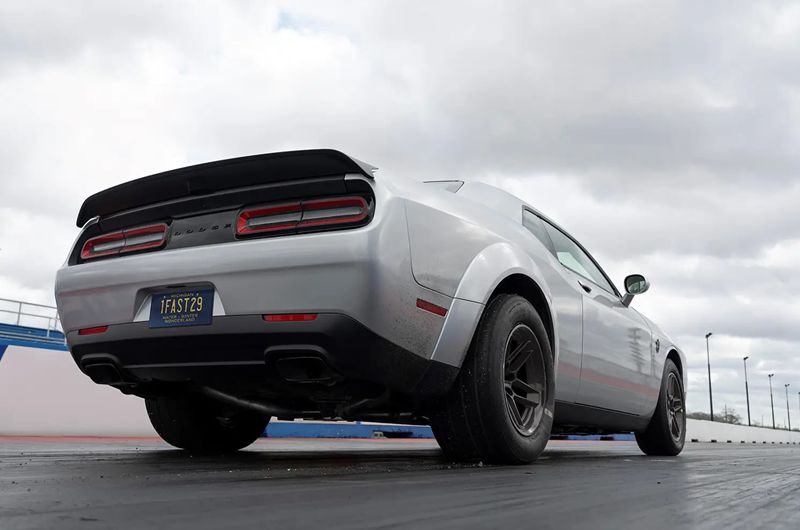Since its debut in 2018, the Dodge Demon has gained cult status among aficionados of muscle cars. The number “170” that can be seen on the Demon’s dashboard is among its most intriguing features. So what does this number actually mean? We’ll delve deeper into the importance of “170” on the Dodge Demon in this blog post.

Let’s start by giving a brief history of the Dodge Demon. From 2018 to 2019, Dodge released the Demon, which was simply a Challenger SRT Hellcat with more power. The Demon was designed specifically to be the fastest production automobile available, and it succeeded in reaching this goal. It was propelled by a 6.2-liter supercharged HEMI V8 motor that could generate 770 lb-ft of torque and 840 horsepower. The Demon was able to sprint a quarter mile in 9.65 seconds and accelerate from 0 to 60 mph in just 2.3 seconds thanks to its incredible power output.

Returning to the number “170,” now. This figure represents the Dodge Demon’s maximum speed. Although the Demon’s top speed is 168 mph, Dodge wished to give drivers a little more comfort. So, to encourage drivers not to go faster than that, they added a “170” decal to the dashboard of the car. This was a safety precaution set in place to prevent drivers from pushing the car too far and endangering themselves and other people.
It’s important to remember that the Dodge Demon wasn’t designed for high speeds. The vehicle was made to be a drag racing machine, despite the fact that it can reach impressive speeds. In actuality, the Demon was the first mass-produced vehicle made especially for drag racing. Numerous engineering innovations developed specifically for the Demon led to the car’s impressive acceleration and quarter-mile time.

So why did Dodge decide to give the Demon a maximum speed of 168 mph? Tire restrictions are the reason for the response. The Nitto NT05R drag radials on the Demon were made especially for drag racing. These tires are not meant to be driven for extended amounts of time at high speeds. In fact, Nitto advises against using these tires at velocities greater than 149 mph. With consideration for the tire limitations, Dodge engineers determined that a maximum speed of 168 mph was safe enough to permit the Demon to be driven on public roads.
It’s also important to note that the Demon has additional safety features in addition to the 170 insignia. Other safety-related features that are included with the vehicle include airbags and anti-lock brakes. These include launch control, a transmission brake, a line lock system that makes burnouts simple, and a transmission brake that prevents the vehicle from rolling forward when staging at the starting line.

Finally, the “170” on the Dodge Demon represents the maximum speed of the vehicle. The Demon was not intended to be a top-speed vehicle, despite the fact that it can reach impressive velocities. Instead, it was designed to be a drag racing vehicle with quick quarter-mile times and impressive acceleration. Drivers are reminded by the 170 decals on the dashboard to be aware of the vehicle’s constraints and to drive safely. If you’re fortunate enough to own a Demon, follow the advice and drive no faster than 170 miles per hour!
The prospect of EV charging stations
As more and more people transition to driving electric vehicles, the future of EV (electric vehicle) charging stations looks bright. The demand for convenient and reachable charging infrastructure is rising along with the popularity of electric cars.
Electric vehicle charging stations are available in a variety of configurations, from Level 1 (which uses a typical 120-volt household outlet) to Level 3 (also known as DC fast charging), which can deliver a complete charge in as little as 30 minutes. Currently, level 2 charging stations are the most popular, offering a complete charge usually in a few hours.
The development of the electric vehicle market is being supported by investments in charging infrastructure from governments and companies all over the globe. Many nations have set high goals for the proportion of electric cars on the road, which will necessitate a substantial expansion of the infrastructure for charging them. Automakers are also working with charging service providers to put in charging terminals at workplaces, retail locations, and public spaces.
The market for charging infrastructure is anticipated to expand quickly in the coming years as the demand for electric vehicle charging stations will continue to rise as more people transition to electric cars. The possibility of electric vehicle charging stations becoming a ubiquitous and crucial component of our transportation infrastructure seems to be increasing as technology advances and more effective and quicker charging solutions are created.
